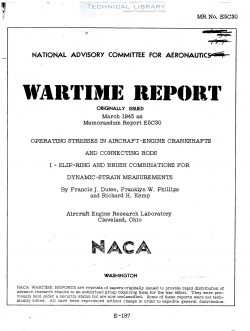naca-wr-e-187
- Version
- 56 Downloads
- 812.91 KB File Size
- 1 File Count
- April 15, 2017 Create Date
- April 15, 2017 Last Updated
Operating Stresses in Aircraft Engine Crankshafts and Connecting Rods - I - Slip-Ring & Brush Combinations for Dynamic-Strain Measurements

The investigation reported herein was made at the NAGA
Cleveland laboratory at the request of the Army Air Forces. Air
.Technical Service Command. and is part of a program to develop
instrumentation for use in determining actual operating stresses
in rotating—shaft systems such as aircraft—engine crankshafts
and connecting rods. Where resistance-wire strain gages are used
to measure dynamic strains, a means of communication between the
strain gages and the instruments recording the strains is necessary.
Slip rings and brushes, or some other type of sliding contact,
are moat commonly used as a means of communication.
Considerable research has been done on the phenomena of
sliding contacts used to transmit electric power. as in the case
of electric motors. The results of this previous work have proved
of little practical value insofar as systems for measuring dynamic
strain are concerned. because strain—measuring systems transmit
only a small amount of electric power. Furthermore. slip rings
and brushes on electric motors are designed to have a low voltage
IAGA MB No. 35030 3
drop and relatively little attention is given to the variations in
the drop. A good sliphring system for measuring dynamic strains can
have.an-appreciable.voltage drop.ubut it is important that the drop
remain constant within very close limits.
The objects of the present investigation were therefore (1)
the development of a sliphring and brush system through which a small
amount of electric power could be transmitted and in which the contact-
resistance change between the slip rings and brushes would remain small
enough that the strain signal would not be obscured by variations of
voltage drop through the slip rings and brushes: (2) the correlation
of data from tests of slip rings and brushes in order to provide a
basis for predicting the performance of similar systems operating under
similar conditions.
| File | Action |
|---|---|
| naca-wr-e-187 Operating Stresses in Aircraft Engine Crankshafts and Connecting Rods - I - Slip-Ring &.pdf | Download |
Comment On This Post